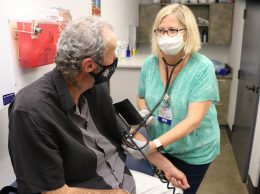Health leaders: ‘Ambitious’ Obamacare goals tough to implement
IN THIS ARTICLE
- Central Coast Topic
- Erika Martin Author
By Erika Martin Wednesday, March 19th, 2014
Uncertainties shrouding Obamacare implementation are leaving many health-care providers strained, and consumers are thus far seeing few of the cost cuts promised by the overhaul.
That was the theme that emerged from a March 18 forum in Santa Barbara hosted by nonprofit Visiting Nurse & Hospice Care.
The law was “very ambitious in its scope and, we’re finding, in the time frame in which it’s being implemented,” said event moderator Michael Bordofsky, medical director of VNCH.
CenCal Health, which administers Medi-Cal in San Luis Obispo and Santa Barbara counties, expects to enroll 30,000 new individuals by the end of 2015, bringing its total to 150,000 in the region, CEO Bob Freeman said. To accommodate the additional patients, CenCal has added 100 in both primary-care physicians and specialists to its system over the past year, Freeman said, including a new network of mental health providers that rolled out in January.
Cottage Health System President and CEO Ron Werft said the the Affordable Care Act makes it difficult for hospitals to maintain the long-term quality of care due to a necessity to execute development in the face of uncertainty. “It’s becoming much more difficult for us to project five or seven years out,” he said, and to make capital investments, especially when it remains to be seen how many additional patients the hospital will need to support.
“Even today, it’s very difficult for consumers to know what’s going on — and that was the goal, really,” Werft said. “It was to get good information for people to make good decisions.”
The act will require Medicare to reduce providers’ base rates up to 3.5 percent annually for the next four years, which will result in a 14 percent decrease in reimbursement from the program for VNHC, according to the nonprofit’s president and CEO, Lynda Tanner. She said patients will also have to pay a new $100 to $150 office co-pay just to be referred to hospice, making them less likely to address health issues until they land in the emergency room.
“The reality is we really won’t be able to have home care any more,” Tanner said.
CenCal’s Freeman said that eventually the state will also ask Medi-Cal to absorb duties for its variety of public programs providing assistance to mental health patients that allows to stay in their home. Additionally, he said 20 percent of the population within CenCal’s footprint is eligible for both Medi-Cal and Medicare, and over the next three to five years it will be expected to assume responsibility for those in that group who are currently enrolled in Medicare.
‘Great opportunity’
However, Kurt Ransohoff, CEO and chief medical officer at Sansum Clinic, said the benefits of expanding access to health insurance outweigh the downsides of implementing the new law. “There’s a great opportunity for a better system and if this is a catalyst for that, it’ll be worthwhile,” Ransohoff said.
For example, the regulations prompted Sansum to invest in the creation of an electronic records system that allows doctors across the Santa Barbara community to access patient history, as well as the patients themselves, he said.
“Fun fact: We have as many 90-year-olds as 20-year-olds signed up for that system,” Ransohoff noted.
Fred Kass, medical director of research and wellness at Cancer Center Santa Barbara with Sansum Clinic, said the legislation does little to address government spending on pharmaceutical drug development for which consumers assume the cost. According to him, a patient without coverage was quoted $12,420 for a month’s worth of colon cancer medication Stivarga.
“The biggest failing of health-care reform, that I’ve seen so far, is that this problem remains unaddressed,” Kass said. “And until it is we’re going to have an uphill struggle.”
Cottage’s Werft said that, for better or for worse, the new law forces providers to critically evaluate and streamline their services in a cost-effective manner.
“There are a lot of things we do in our health-care system that just don’t add value,” Werft said. “We’re seeing really creative solutions from within our organization that are not so much a response to the [provisions of] the Affordable Care Act as they are a response to the problem [of implementing it].”










